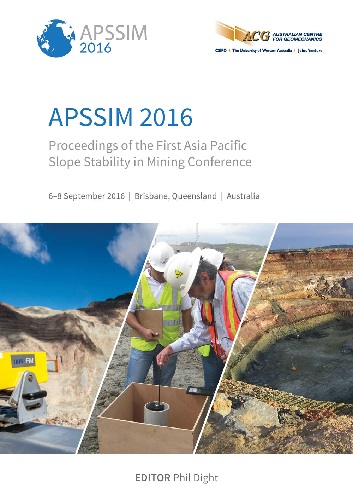An alternate approach for deriving rock slope shear strength parameters within weak jointed rock masses

|
Authors: Narendranathan, S; McBeath, S; Ayemin, K; Lee, EC |
DOI https://doi.org/10.36487/ACG_rep/1604_50_Narendranathan
Cite As:
Narendranathan, S, McBeath, S, Ayemin, K & Lee, EC 2016, 'An alternate approach for deriving rock slope shear strength parameters within weak jointed rock masses', in PM Dight (ed.), APSSIM 2016: Proceedings of the First Asia Pacific Slope Stability in Mining Conference, Australian Centre for Geomechanics, Perth, pp. 721-730, https://doi.org/10.36487/ACG_rep/1604_50_Narendranathan
Abstract:
A variety of rock mass strength models are used by rock mechanics practitioners to evaluate the strength of a rock mass, which will ultimately resolve its integrity (stability) within a slope. It is the author’s intent to emphasise the differences in the mechanical behaviour of weak foliated rock masses, in comparison to stronger rock masses, and highlight that when dealing with weak materials in a low confinement environment, careful consideration needs to be given to defining the limit state strengths. This is particularly significant when dealing with foliated materials that have significant structural control. In the author’s experience, the typically used Barton Bandis shear strength evaluation process for defect plane shear strength evaluation can sometimes overestimate strengths at low confinement. The approach put forward by Ryan (2005), appears to be more appropriate for assessing defect plane shear strengths at low confinements. This approach however remains somewhat limited in its development and use. The authors have applied Ryan’s method in back analysing shear strengths for an instability that occurred within a weathered and jointed rockmass. The results proved useful for site specific use, in future designs, though further work is required to make this relationship generally applicable.
References:
Barton, NR 1974, A review of the shear strength of filled discontinuities in rock, Norwegian Geotechnical Institute, no. 105, Oslo.
Barton, NR 1976, ‘The shear strength of rock and rock joints’, International Journal of Rock Mechanics and Mining Sciences, vol. 13, no. 10, pp. 1–24.
Barton, NR & Bandis, SC 1982, ‘Effects of block size on the shear behaviour of jointed rock’, in 23rd U.S. Symposium on Rock Mechanics, Berkeley, pp. 739–760.
Barton, NR & Bandis, SC 1990, ‘Review of predictive capabilities of JRC-JCS model in engineering practice’, in N Barton & O Stephansson (eds), International Symposium on Rock Joints, Rotterdam, Balkema, pp. 603–610.
Call, RD 1985, ‘Evaluation of material properties’, in MK McCarter (ed.), Design of Non-Impounding Mine Waste Dumps, pp. 35–46.
Deere, DU & Miller, RP 1966, Engineering classification and index properties of rock, technical report no. AFNL-TR-65-116, Albuquerque, Air Force Weapons Laboratory.
Jaeger, JC 1971, ‘Friction of rocks and stability of rock slopes’, Géotechnique, Eleventh Rankine Lecture, vol. 21, no. 2, pp. 97–134.
Narendranathan, S 2011, ‘Determination of shear strength parameters for foliated rock masses’, in International Symposium on Slope Stability, Vancouver.
Patton, FD 1966, ‘Multiple modes of shear failure in rock’, in Proceedings of the First Congress of the International Society of Rock Mechanics, Lisbon, vol. 1, pp. 509–513.
Ryan, TM 2005, ‘Shear Strength of Closely Jointed Porphyry Rock Masses’, in 40th U.S. Symposium on Rock Mechanics, American Rock Mechanics Association, vol. 1, pp. 307–319.
© Copyright 2025, Australian Centre for Geomechanics (ACG), The University of Western Australia. All rights reserved.
View copyright/legal information
Please direct any queries or error reports to repository-acg@uwa.edu.au
View copyright/legal information
Please direct any queries or error reports to repository-acg@uwa.edu.au